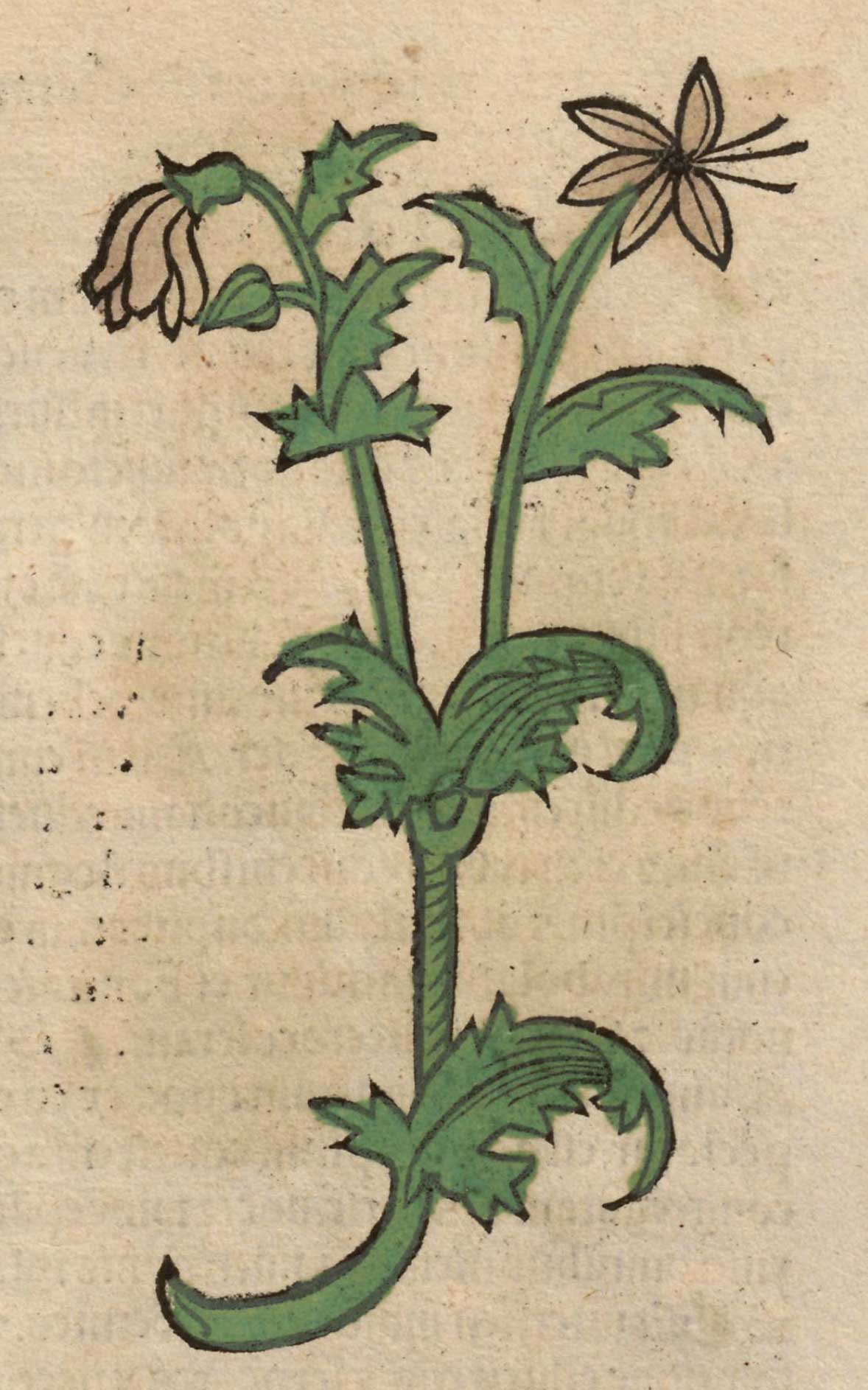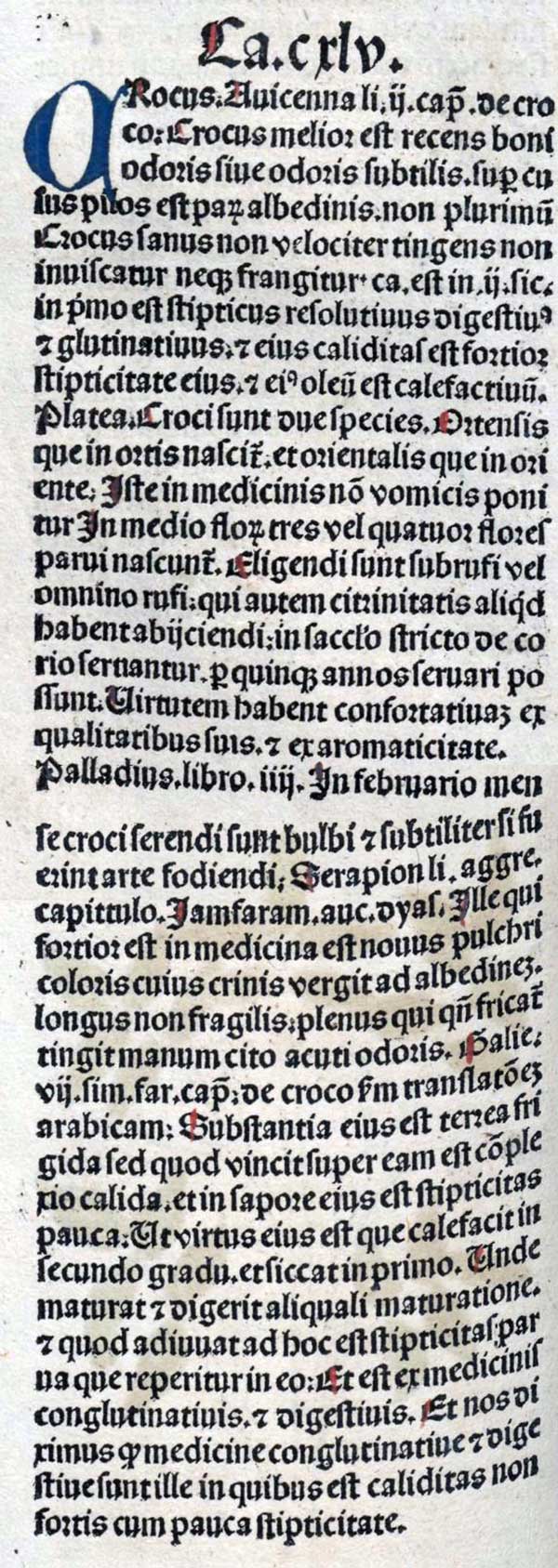Among plants named by metamorphosis of men or women.
Notes
Crocus
Crocus (text)
Saphran
For the loves of Crocus, who was turned into a saffron-flower, and Smilax, cf. Ovid Met. iv 283.
saphran
How you also, Celmis, now adamant, were once most faithful friend of little Jove; how the Curetes sprang from copious showers; how Crocus and his beloved Smilax were changed into tiny flowers. All these stories I will pass by and will charm your minds with a tale that is pleasing because new.
saphran
Ovide (Mét., IB, 283) rapporte que le jeune Crocus, fort amoureux d’une fillette, fut métamorphosé en plante. Ce nom vient plutôt du grec, χρόχοζ (de χρόχη, fil ou trame, par allusion aux franges des stigmates de la plante, seuls employés en thérapeutique). D’ailleurs les étamines florales se nomment en grec χροχύδεζ.
Pline (XXI. 17) mentionne le Crocum silvestre et le C. sativum; ils correspondent à notre Crocus sativus, :L. (Iriacée). (Paul Delaunay)
crocus
Crocum silvestre optimum. serere in Italia minime expedit, ad scripula usque singula areis decoquentibus. seritur radicis bulbo. sativum latius maiusque et nitidius, sed multo lenius, degenerans ubique, nec fecundum etiam Cyrenis, ubi semper flores laudatissimi. prima nobilitas Cilicio et ibi in Coryco monte, dein Lyciae monte Olympo, mox Centuripino Siciliae. aliqui Theraeo secundum locum dedere. adulteratur nihil aeque. probatio sinceri, si inposita manu crepitet veluti fragile; umidum enim, quod evenit adulteratione, silet.1 altera probatio, si manu relata ad ora leniter faciem oculosque mordeat. est per se genus sativi blandissimum vulgo, cum sit mediocre, dialeucon vocant. contra Cyrenaico vitium, quod omni croco nigrius est et celerrime marcescit. optimum ubicumque quod pinguissimum et brevis capilli, pessimum vero quod situm redolet. Mucianus auctor est in Lycia anno septimo aut octavo transferri in locum subactum atque ita degenerans renovari. usus eius in coronis nusquam, herba enim est folio angusto paene in capillamenti modum. sed vino mire congruit, praecipue dulci, tritum ad theatra replenda. floret vergiliarum occasu paucis diebus, folioque florem expellit.1 viret bruma et colligitur. siccatur umbra, melius etiam hiberna. carnosa et illi radix vivaciorque quam ceteris. gaudet calcari et adteri, pereundoque melius provenit. ideo iuxta semitas ac fontes laetissimum. Troianis temporibus iam erat honos ei. hos certe flores Homerus tris laudat, loton, crocum, hyacinthum.
Wild saffron is better than any other. To grow it in Italy is most unprofitable, as a whole bed of saffron yields only a scruple of the essence. It is propagated from a bulb of the root. The cultivated saffron is broader, larger and more handsome, but much less potent; it is degenerating everywhere, and is not prolific even at Cyrene, where grows a saffron whose flowers have always been very famous. But the prime favourite is that of Cilicia, and in particular of Mount Corycus, then that of Mount Olympus in Lycia, and then that of Centuripa in Sicily. Some have given second place to the saffron of Thera. Nothing is adulterated as much as saffron. A test of purity is whether under the pressure of the hand it crackles as though brittle; for moist saffron, as saffron is when adulterated, makes no noise. Another test is whether it stings slightly the face and eyes if after the above test you bring the hand back to the face. There is a kind of cultivated saffron which is for its own sake very attractive to the general public, though it really is of moderate value, called dialeucon. That of Cyrene, on the other hand, has the defect of being darker than any other kind, and loses its quality very rapidly. The best everywhere is that having a very rich nature, and a short pistil; the very worst has an odour of decay. Mucianus is our authority for stating that in Lycia after six or seven years it is transplanted to a well-dug bed; in this way it recovers from its degeneration. It is nowhere used for chaplets, the plant having a leaf that is but little broader than the fibre.d But with wine, especially with sweet wine, powdered saffron makes a wonderful mixture to spray the theatre. The saffron plant flowers for only a few days at the setting of the Pleiades [Theophrastus has (H.P. VI. 6, 10) <μετὰ> Πλειάδα γὰρ ἀνθεῖ καὶ ὀλίγας ἡμέρας· εὐθὺς δ᾿ ἅμα τῷ φύλλῳ καὶ τὸ ἄωθος ὠθεῖ. Hort translates “after the rising of the Pleiades” (i.e. May). Surely this is wrong; it is the setting of the Pleiades in November to which reference is made. But Pliny mistranslates εὐθὺς δὲ κ. τ. λ., which means that the flower springs up at the same time as the leaf], and pushes off the flower with its leaves. It is green at the winter solstice, when it is gathered. It is dried in the shade; if in winter, so much the better. The root also is fleshy and longer-lived than that of any other plant. Saffron likes to be trodden on and trampled under foot; destroying it makes it grow better. For this reason it is most luxuriant near foot-paths and fountains. Already at the time of the Trojan war it was held in high esteem. Homer, at any rate, praises three flowers—lotus, saffron and hyacinth [Iliad XIV. 348].
crocus
thus Crocus, a lovesick suitor, and smilax, after the maid he pined for…
saphran
Pour saphran (crocus) voir Textor, Officina, d’apres Ovide, Metam, IV 283.
Saphran
Crocus, amoureux d’une fillette, fut métamorphosé en safran (Ovide, Métamorphoses, IV, v. 283).
saffron
saffron. [adopted from French safran (12th c. in Hatzfeld and Darmesteter, Dictionnaire général de la langue française) The ultimate source is Arabic zafaran (adopted unchanged in Turkish, Persian, and Hindustani); also Jewish Aramaic za perana). The Arabic word with prefixed definite article, azzafaran, is represented by Spanish azafran, the word without this prefix gives rise to Ital. zafferano, zaffrone, Provençal safran, safrá, French safran, medieval Latin safranum, medieval Greek zafraj, modern Greek safrani, Russian shafran. The origin of Arabic zafaran is unknown; it is not connected with çafra fem. of açfar yellow. The Turkish synonym çafran (Zenker; given in Redh.-Wells only as an incorrect pronunciation) may however be derived from this adj., and may be the source of some of the European forms.]
An orange-red product consisting of the dried stigmas of Crocus sativus. Now used chiefly for colouring confectionery, liquors, etc., and for flavouring; formerly extensively used in medicine as a cordial and sudorific.
C. 1200 Trinity College homilies Homer 163 Hire winpel wit oðer maked 3eleu mid saffran.
A. 1350 St. Stephen 318 in Carl Horstmann, editor, Altenglische Legenden (1881) 32 The ferth [panier]..ful of safron semyd it right.
C. 1386 Chaucer Sir Thopas 19 His heer, his berd was lyk saffroun.
C. 1450 Two Cookery-bks. 70 Cast thereto Sapheron and salt.
C. 1460 Play Sacram. 177 Peper and saffyron and spycis smale.
1572 in Feuillerat Revels Q. Eliz. (1908) 176 Cloves and saferne.
1582 N. Lichefield tr. Castanheda’s Conquest. E. Ind. 91 A bason of silver to wash his hands in, full of Saforne.
1611 Shakespeare The Winter’s Tale iv. iii. 48, I must haue Saffron to colour the Warden Pies.
1685 Temple Ess. Health Wks. 1731 I. 284 Saffron is of all others the safest and most simple Cordial.


Le dernier chapitre du Quart livre des faicts et dicts heroïques du bon Pantagruel (publié en 1552 à Paris chez Fezandat) se paie la tête (ou plutôt le cul) de Panurge en le montrant si saisi de peur quand il entend le bruit du canon qu’il se conchie : « Car un des symptomes et accidens de paour est, que par luy ordinairement se ouvre le guischet du serrail [le sphincter] » qui retient normalement jusqu’au moment voulu « la matiere fecale » (QL, lxvii, 698). Mais Panurge, après avoir été la risée de ses compagnons, retrouve son aplomb habituel pour proclamer que ce qui a souillé sa chemise n’est ni « crottes, merde, fiant, dejection […] », mais du safran d’Hibernie : « C’est (croy je) sapphran d’Hibernie. Ho, ho, hie. C’est sapphran d’Hibernie. Sela, Beuvons. » Et le livre se termine sur ces joyeuses paroles.
Rire jaune – l’énigme du safran au final du Quart Livre
Du jeu philologique à la satire politique
Type de publication: Article de revue
Revue: L’Année rabelaisienne
2022, n° 6. varia